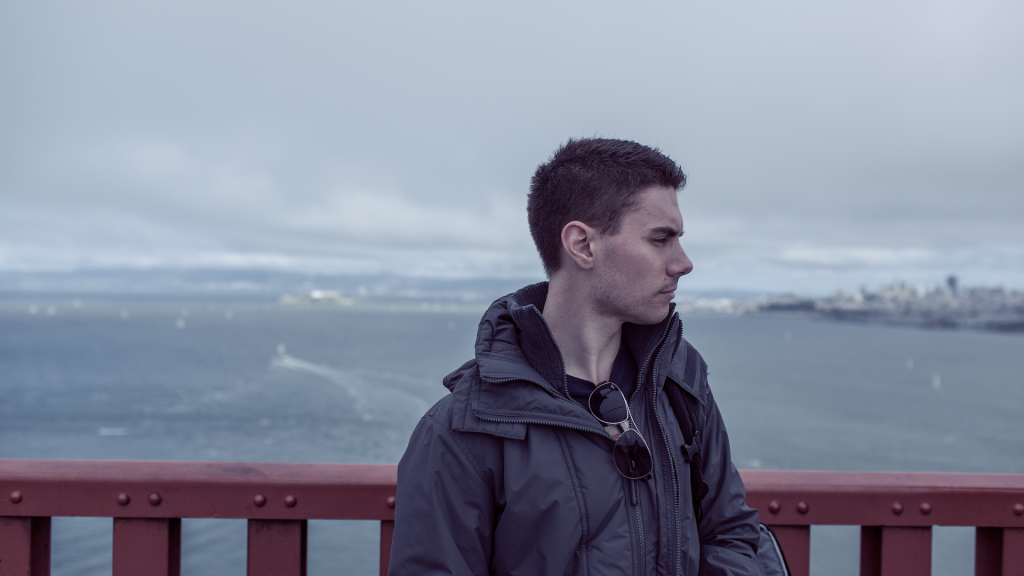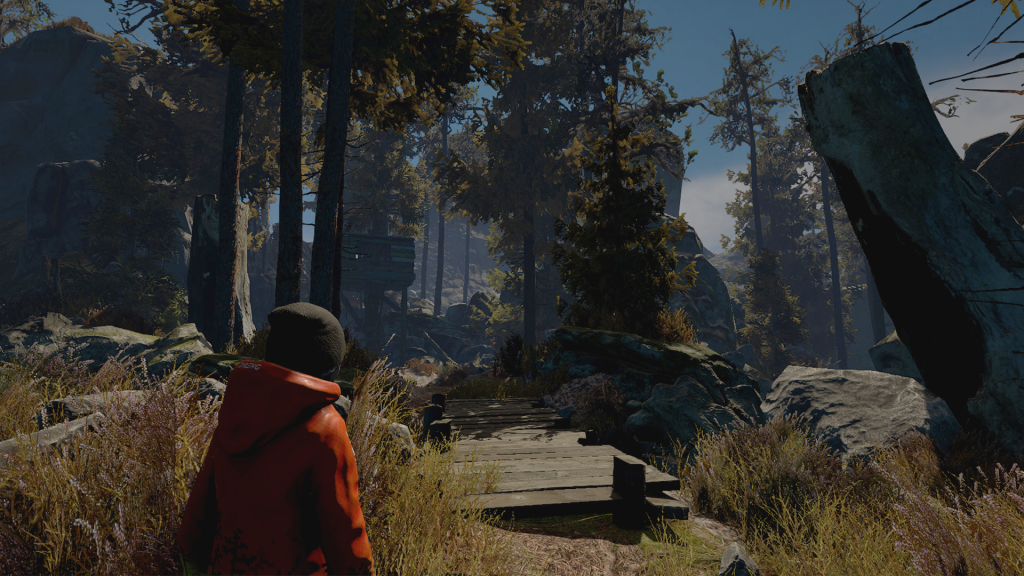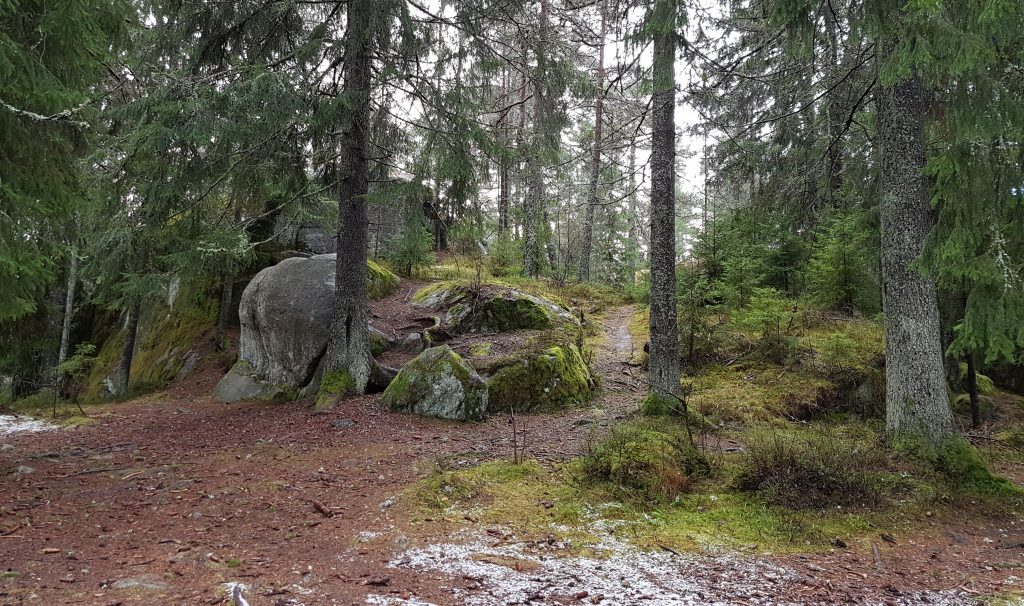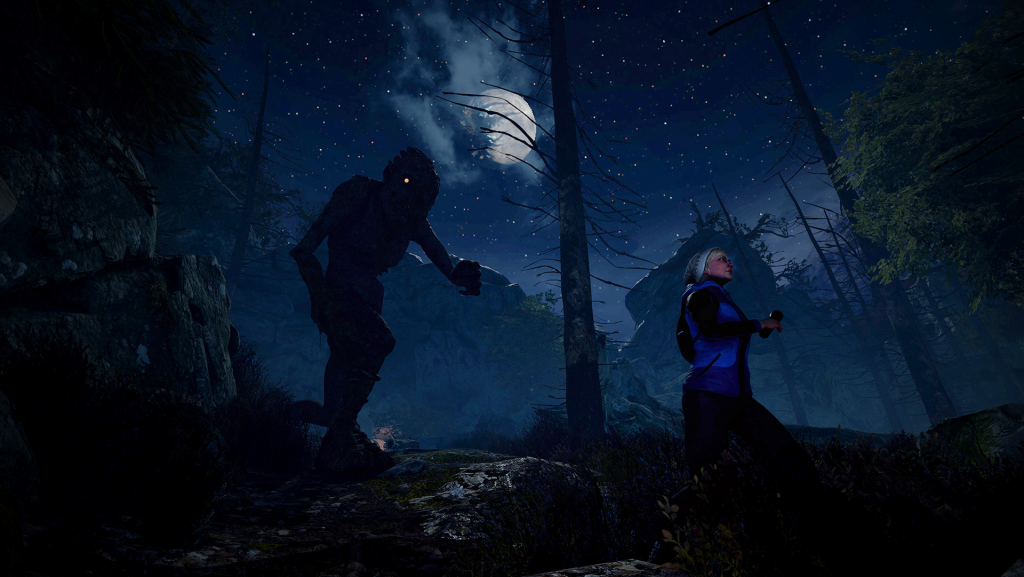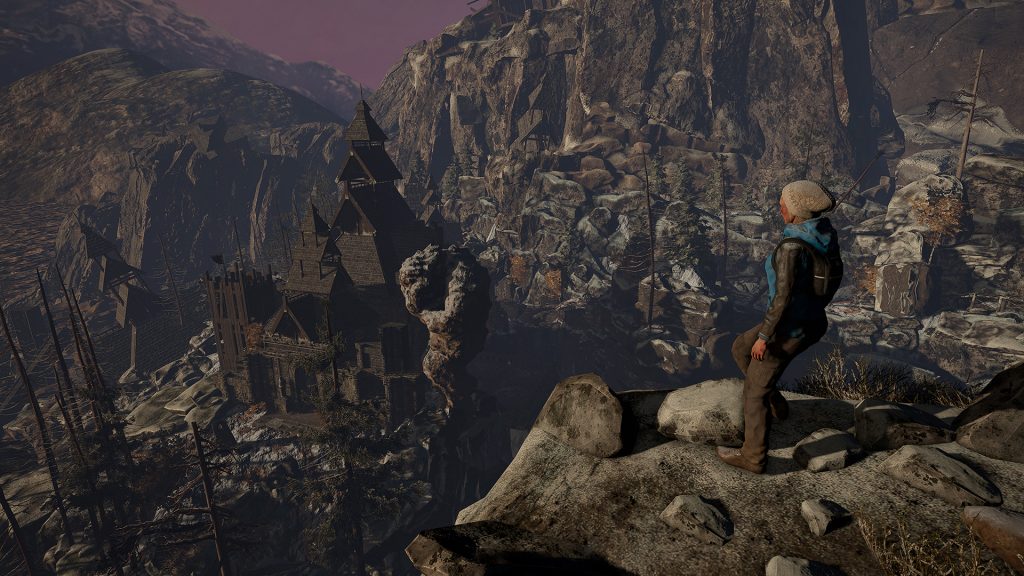It began as a student project and became a successfully-funded Kickstarter, a GDC “Best in Play” exhibitor, and the “Sound of the Year” winner at the 2015 Norwegian Game Awards. After three years of hard work, Through the Woods was publicly released last month to let players traverse its immersive and fantastical landscape full of the usual Norwegian things: fjords, lush forests, trolls—wait, trolls? Dan Wakefield, Antagonist studio’s CEO, sound designer, composer, writer, director and all around creative workhorse was kind enough to share with us the creative ideas behind the game and how they melded the authentic Nordic soundscapes with ominous Kittelsen-inspired folklore.
Please introduce yourself:
Dan Wakefield: Hi, I’m Dan. I’m the sound guy and writer at Antagonist, a small indie game studio based in Oslo.
Recently, Antagonist released Through the Woods. Could you tell us a little about this game?
DW: Through the Woods is a third-person horror adventure set in Norway. You play as a woman whose son is taken from her and dragged through a forest in which creatures and characters from Norse mythology and Norwegian folktales are real. The game is often equal parts scary and melancholy as you find out more about the mother’s past.
When did production for Through the Woods begin? Could you tell us a little more about Antagonist and your role in the team?
DW: Through the Woods actually began as a student project in 2013. Full production began in Spring 2014 when the company got a small investment. I became involved with the project through the creative director, who I worked with at a bar in Oslo. We had two programmers, two artists, a game designer, a creative director and a producer, and I was initially the composer working freelance. I also did a little bit of marketing, blogging and community management. I very soon became the sound designer as well after working on the initial teaser trailer. By January 2016, some of the team had moved on and we hired a few new members so the entire makeup of the team was different. By that point I was the CEO, writer, sound designer and composer, and doing all the social media stuff.
You are a man of many hats! It’s especially rare for the sound designer to be the writer, too. How did you approach the writing?
DW: I took on the role of writer about halfway into production. I ended up only keeping the outline of the game concept and some of the story beats. I had to write the in-game dialogue, the tape dialogues, and all the journals you find around the game world. I found that the only way I could do it and make sure the pacing was good and that all the twists and turns were revealed at the appropriate times was to write the game as a screenplay. The screenplay reads almost like a book and I’m actually making a text-based adventure game of Through the Woods for mobile platforms as well, as a lot of the writing is already there.
Though you live in Oslo now, you are originally from England – but have you always been drawn to Scandinavia?
DW: I can’t really claim I have any prior history with Norway or Scandinavia. I moved here because my partner is Norwegian. We met when I was 17 and she was 16 and it was very a novel thing for me to have a foreign friend. So Norway was on my radar years before I moved here, but I still can’t say I knew much about Norway before she and I moved in together many years later.
Now that I am here, however, it’s just really interesting. It’s so different from the UK in so many ways and I have been trying to soak up the culture here as much as I can. I went cross-country skiing for the first time in my life, aged 25 or something, which I think the Norwegians found very amusing. It’s not often you see someone of my age as clumsy as I am out there skiing. We go on trips to my girlfriend’s parents’ cabin in the mountains for hiking and skiing, and we go sailing and walking in the forest. Norwegians have a very deep connection to nature, which I have been trying hard to nurture in myself. Norwegians are so honest in many ways, too. I’ve seen people leave their cameras, iPads and computers in a crowded bar to go to the bathroom. No one expects their things to get taken. Norwegians seem to have a lack of cynicism I find very charming. It’s just different from England.
In Through the Woods, authenticity seems to have been a goal. In other interviews, you mentioned all the model textures were created from photographs of Sognsvann, Norway, and besides a few laborious bird calls, the sounds were original, too. How did you approach this massive amount of field recording and create such rich natural soundscapes?
DW: The soundscape was really fun and interesting to create. It’s become a bit of an obsession of mine over the past few months, zipping around in the game engine thinking about what could make this or that area feel more real. When I walk between two tall rocks or when I go near the edge of a cliff or around the side of a house, I want the sound to change, for the wind to die down slightly or to sound like it’s blowing against a rock face, and that’s what I’ve done.
It’s taken me almost three years to collect the sounds for Through the Woods. I started off with just two ambiences when we made our prototype, both recorded in my garden. They were plonked in the game in stereo, and there weren’t any 3D sounds like individual trees blowing, wind whistling, etc., just footsteps and these two layers of outdoor ambience. Now we have an ambient sounds manager that our programmer created for me so I can set a default ambience for a whole stage, which I make by blending three or four different ambiences together very quietly. Then I run around the stages sticking ambience zones on houses, caves, and such to create the ‘inside sounds’, so when you go into a hut, the sound will change and the wind will die down. Then there are maybe 1,000 sound sources in each stage that loop around endlessly: every tree has a sound, the huts creak, outcropping rocks have wind blowing past them, patches of grass blow around. There are 16 long tree loops, and about the same amount of wind loops, culled over the months from a much bigger collection of maybe 60 loops. They’re long and varied and the start points of the loops are randomized, which means even if there were three trees together that somehow all had the same loop, it would still sound like three different trees.
You spend almost the entire game outside, so I wanted as much audio as I could manage to be recorded outdoors. I don’t really know if this was a good decision on a technical or even on a common sense level, but I’m happy with the results on a personal level. The footsteps, for example, would normally be recorded in a studio. I recorded mine in a forest in the middle of the night over several days. I think I have 25 steps per foot for each surface and footstep type – the terrain types being forest ground, rocks, moss, grass, wood, snow, puddles and ankle-deep water through walking, running, sneaking, jumping and landing. So there are a lot of footsteps! I added jacket swish between every step and the tiny jangling of her coat zippers to about 40% of the steps to give the footsteps even more variation. It took a lot of editing and treatment to get them clean enough to use and still sound full and natural, a problem I would not have had if I had recorded them at my studio, but I’m glad I did it this way. At least I can say that as you walk along in the game that it was recorded deep in a Norwegian forest.
In managing such a huge amount of assets, what was your workflow like? Did you use any middleware?
DW: My workflow is completely erratic. Sometimes I float around in the game engine and spot, for example, a flag that doesn’t have a sound, and I will run around trying to find a flag to flap. Sometimes I will go outside, capture some audio, edit it and stick it in the game and then I’ll notice some other sound I want and will put my shoes back on and go outside to find it. Luckily I am an in-house sound designer so I’ve had the luxury of recording, scrapping and re-recording so many elements of the sound design. I’m never happy with my own work for long, so it’s nice I have had the time and freedom to redo things I’m not satisfied with.
My setup is pretty basic. I have a pair of Sennheiser MKH 8040’s which I use for almost everything outdoors. I love them because I think they’re very honest and have a pretty high frequency response (50kHz-ish), which has been useful for pitching stuff when I need to. I used the 8040 on almost all the monster vocalisatons as they are almost all pitched down. I did the vocals for a lot of the creatures myself using a pitch shifter, EQ and a granular filter. That was some of the sound design I found most fun to create.
I often use my Neumann U87 indoors. I have lots of creaky doors and such in my building, and I almost never fail to get something lovely with the U87. Same with things like bloody squelching and juicy eating sounds for the death scenes.
I use a little Zoom H6 for field recording. I have wanted to buy a Sound Devices field recorder for several years but the prices of these units in Norway make my eyes water. The H6 has many, many flaws and juggling it around with the easily moved volume knobs, has caused me to want to throw it into the woods a few times, but I’m very happy with the end results. I usually do a lot of surgical editing with RX to remove noise I don’t like and I’ve used the Waves restoration tools a lot. Alone the tracks can sometimes sound not quite right, but when they are all mixed and blended in layers in-game, I’m very happy with the sounds.
When it comes to the atmosphere, the game is described as “attempting to capture the forest as we saw it as children, with all the frightening and mysterious feelings of roaming the woods alone,” and you mention that in Norway you “can totally understand how you can peer into the darkness under a tree and create stories about little creatures looking back at you.” How did you capture and design these feelings of nostalgic mystery and folklore in the sound?
DW: I think a lot of the feeling of mystery and evoking the Norse feeling is actually helped by the music. I bought a handmade Finnish jouhikko, like a lyre with a horsehair bow, which produces a beautifully scratchy old Norse sound. I used it in the sound design as well because it sounds unique, but when you hear this thing, it just yells, ‘Norse!’ I have an old goatskin drum that I pitched down to make it sound large which certainly gives a very Nordic texture when played with the right rhythm. So these things help with communicating to the player they are in a place that is essentially an amazingly preserved Viking island.
But as far as trying to design the sound of Norwegian folklore, that’s much more difficult to answer. I did do a lot of research on Nordic and specifically Norwegian folk music, but it was extremely difficult for me to actually get to grips with what made the Norwegian folk music sound Norwegian. I haven’t been steeped in the music and culture long enough, I guess.
There are several times where creepy visuals are understated by the audio and even silence. The game doesn’t depend on jump scares and contains a lot of navigating through darkness, so the sound design encourages close listening, which makes the natural sounds even creepier. How did you achieve this effect and how did you approach horror sound design? What were some of your influences?
DW: My aim in this game has always been to get the environment to sound great first. I spent a lot of time making sure wherever you walk in the game you should hear what you would hear in real life. For me, once the environment sounded just right, the player would be immersed and that would give me some space to create tension. In an early stage, I had lots of scary sound design and weird noises: I scraped guitars with violin bows and pitched them way down, I made lots of scary musical elements and triggered them through the stages to keep players on their toes. But I started to feel like it was all fluff somehow. When you hear a big musical scrape or some creepy breathing that is not connected to some kind of creature or event, it all started to feel fake to me. Or, maybe cheap is a better word. I liked the atmosphere it created, but I knew it was just scary sounds for the sake of scary sounds. I decided that the random sounds in the game should be monsters in the distance, the felling of a tree splashing in the water nearby, a twig snapping, etc. This limited me a lot actually, and I regret the decision on and off. Having a bunch of random sounds is a very good way to keep tension up and make people nervous. I just wondered if I could actually create a similar feeling with the exact opposite of a lot of creepy sounds: just the sound of a scared person walking through the forest.
That design concept is quite challenging, though I think what you said in the past came through in the game – there is anxiety in feeling safe and knowing you’ll have to leave that safety. What were some other challenges you faced in designing the sound?
DW: The whole process has been a challenge for me, actually. I’m not a sound designer by education; I’m a musician. I fell into the role by chance and, even after three years, I still don’t think like a sound designer. I don’t carry my recorder or microphones with me anywhere if I’m not out looking for something to capture. Every sound I need, I think, ‘Where would I find something like that?’ and I go out and find it. I also used almost no imagination or even much creativity for most of the sound design in the game. When I needed the sound of a body falling on the ground, I set up two mics in the garden and threw myself on the ground hard a couple of times. When I needed creaking gates or latches, I’d walk down the road at night and find a gate that looked like the one in the game and record it. I think I thought doing it this way would create a form of authenticity, but I probably could have been much more creative with my sound sources.
After having worked on this game full-time since 2014, what is next for you?
DW: Ah! That question is a little tough to answer! A lot depends on how the game sells. Right now we’re focusing on making sure the game sells and supporting the game with bug fixing and patches. We’re even releasing physical copies in some countries in the upcoming weeks. As I mentioned before, I’m working on a Through the Woods text adventure, which is kind of like a choose-your-own-adventure that follows the same story as the game, with different routes through various areas and choices to make. We’d really like to get the game out on consoles as well, which is something we’re feeling out at the moment.
Thank you very much for speaking to us! If people want to learn more about Through the Woods or follow your personal work, where can they go?
DW: Thank you very much for having me! It’s been really fun! Here are a couple of ways to find out more about Through the Woods: You can visit our website, you can like us on Facebook, you can follow us on Twitter, and if you want to buy Through the Woods, you can buy it on Steam. You can follow me personally on Twitter @dantagonism.
